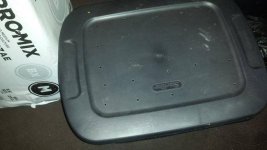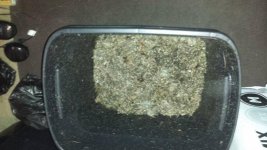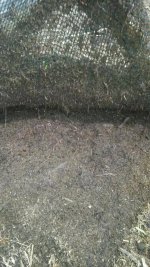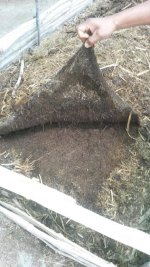thejact55
Well-known member
Alot of the below information is redundant, if you read the whole thread. Sharing my experienced with my first worm bin. Pics were taken a couple weeks back, I have even more castings to this point. On my next run, I am going to fortify by feeding them nettle, comfrey and dandelion as well.
I bought two rubber bins, the same size. Think they are 15 gallons (approx 60 liters). The first bin, I just tossed the lid and put 6 bricks in the bottom. This is a catch bin for any liquid that comes down. I then drilled 6 tiny holes in the bottom of the second bin and placed it on top of the bricks sitting in the first bin. I then drilled a lot of holes in the lid (like 48 holes?) and 12 holes around the top exposed part of the bin. This will allow air to enter. I used a paper shredder to shred newspaper. Just basic news paper, no shiny glossy stuff, nor any normal white paper, as this has bleach and such. You can fill up the bin quite a bit, but mine is only half full. I added and mized water into the newspaper. Not sopping wet, just wet enough to compress and it it will stick together in a ball. I then added a handful of soil and a handful of azomite rock dust to aid in the digestion or chewing of the food for the worms. I bought 500 red wriggler worms off the internet. they arrived a few days later, very healthy. I later bought 300 worms locally, that I was not as impressed with health wise. They breed and double population every few months or so. I feed them fruit and veggies, coffee grounds with the filter, oats, dead leaves/live leaves, rinds from fruit, and other organic foods. No meat, salty foods, onions/garlic, feces or other processed junk. I chop these up really small or use a food processor to make a mush, so the worms can eat it quicker. I usually add kelp meal, alfalfa meal and azomite, as they like this and I assume it might make a better worm casting. I feed them about once a week. Rule is half their weight is what they can eat in a day 1000 worms is a pound, so half pound a day. I find this over-kill. I feed them about a pound a week. I make little food pockets in different places in the bin. bury the food and make sure it is covered with newspaper. I keep this inside, and there is no foul smell. Castings are coming along nicely, I think another month, and i will been done with this run.
I bought two rubber bins, the same size. Think they are 15 gallons (approx 60 liters). The first bin, I just tossed the lid and put 6 bricks in the bottom. This is a catch bin for any liquid that comes down. I then drilled 6 tiny holes in the bottom of the second bin and placed it on top of the bricks sitting in the first bin. I then drilled a lot of holes in the lid (like 48 holes?) and 12 holes around the top exposed part of the bin. This will allow air to enter. I used a paper shredder to shred newspaper. Just basic news paper, no shiny glossy stuff, nor any normal white paper, as this has bleach and such. You can fill up the bin quite a bit, but mine is only half full. I added and mized water into the newspaper. Not sopping wet, just wet enough to compress and it it will stick together in a ball. I then added a handful of soil and a handful of azomite rock dust to aid in the digestion or chewing of the food for the worms. I bought 500 red wriggler worms off the internet. they arrived a few days later, very healthy. I later bought 300 worms locally, that I was not as impressed with health wise. They breed and double population every few months or so. I feed them fruit and veggies, coffee grounds with the filter, oats, dead leaves/live leaves, rinds from fruit, and other organic foods. No meat, salty foods, onions/garlic, feces or other processed junk. I chop these up really small or use a food processor to make a mush, so the worms can eat it quicker. I usually add kelp meal, alfalfa meal and azomite, as they like this and I assume it might make a better worm casting. I feed them about once a week. Rule is half their weight is what they can eat in a day 1000 worms is a pound, so half pound a day. I find this over-kill. I feed them about a pound a week. I make little food pockets in different places in the bin. bury the food and make sure it is covered with newspaper. I keep this inside, and there is no foul smell. Castings are coming along nicely, I think another month, and i will been done with this run.








